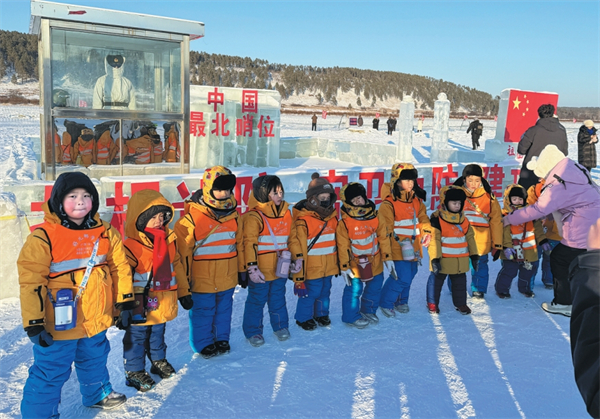Home>Harbin Today
New intercontinental railway reflects the sudden rise of NE China
Updated : 2015-07-02
By ( e.my399.com )
On June 13, in the city of Harbin, Heilongjiang province, a freight train with 49 containers of cargo worth $3-million began a 9,820-km journey to the German port city of Hamburg, and entered Russia from Manzhouli, Inner Mongolia, then joined Russia’s Trans-Siberian Railway line, then on to Yekaterinburg and Moscow and Poland, arriving in Hamburg, on June 27.

Freight train preparing to leave Hamburg, Germany for Harbin, on June 27. [Photo provided to China Daily]
That very same day, a train laden with auto parts, beer and consumer goods left Hamburg, bound for Harbin. What’s the connection? It’s a new cargo service created in response to China’s new "Belt and Road Initiative” which is meant to revive the glories of the ancient Silk Road trade route by building a China-Mongolia-Russia Economic Corridor and the Heilongjiang Land and Maritime Silk Road Economic Belt.
Harbin was long considered an open, international city going back to the late 19th century, but at that time Russia’s Tsarist government railway line in Northeast China was used to plunder its resources and control the Far East. The line extended eastward to the Pacific Ocean and westward to Europe, with Harbin as a sort of hub. You could say the city was born with the railway, since it brought an influx of foreign immigrants, business and prosperity to the city, even though it was invasive.

Train departing Harbin for Hamburg, on June 13. [Photo provided to China Daily]
Now, the railway line is a part of China’s Silk Road Economic Belt running across Asia to Europe and 21st Century Maritime Silk Road, running all the way to Africa. And it has great commercial value along the way.
Peng Jielin, the deputy head of Heilongjiang’s development and reform commission, says that cargo going to Europe from China’s Pearl River Delta, Yangtze River Delta and Bohai-Sea areas will cost less than goods transported through the Xinjiang Uygur region or via the city of Erenhot, Inner Mongolia and that the weekly train service is also more economical, convenient and safer. It takes about 15 days fewer than by sea and costs about $2,000 less than other railway routes.
By the end of this year, the train is expected to have made 26 trips, carrying goods from major cities and ports in Liaoning, Jilin and Heilongjiang provinces in the Northeast, the Bohai area in the North and East, as well as Japan and South Korea, accounting for about 50 percent of the cargo, while cargo from Europe, including Germany, Poland, the Czech Republic, France, Hungary, and Spain will head this way, providing door-to-door delivery service both ways.
Wang Fukuan, deputy head of Harbin Customs, says that the train will open a new logistics channel for China’s imports and exports, and promote economic and trade cooperation among China, Russia, and Europe, and it can bring more resources, technology, and capital to Heilongjiang for production and development of trade and industries all along the line.
The people of Harbin are a bit edgy when it comes to the history of the railway, which was a sort of shackle that the Tsarist government used to control the Northeast and a way to take away the loot. Now, however, the new train service can heal the wounds and humiliating of the past while bringing prosperity.

Harbin ramps up childcare services
A new comprehensive service center for childcare in Harbin is expected to be finished by the end of the year.
-
Talent policies drive enterprise development in Harbin
Harbin's "30 New Talent Policies" represents an iterative upgrade to the talent policy system, helping attract and retain talent to bolster economic and social development.
-
Official website of 2025 Asian Winter Games goes live
Harbin, the host city of the 9th Asian Winter Games, has announced that the official website for the 2025 event has recently gone live.
-
Harbin launches measures to facilitate more foreign trade
In the first three quarters of 2023, the total import and export value of Heilongjiang province's goods trade hit 218.22 billion yuan.





